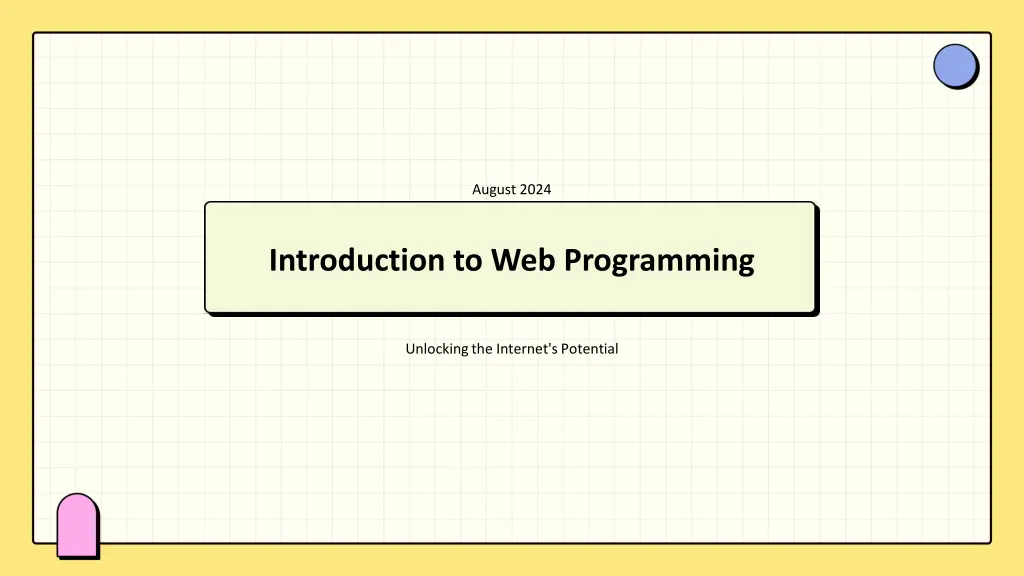
Unlocking the Internet's Potential: An Introduction to Web Programming
Explore the evolution of the Internet from its conceptualization in the 1960s to key milestones like Google and Facebook. Understand the role of web browsers, web page structures, HTML, CSS, and JavaScript in web programming. Discover the impact of server-side technologies and the future of web development.
Uploaded on | 0 Views
Download Presentation

Please find below an Image/Link to download the presentation.
The content on the website is provided AS IS for your information and personal use only. It may not be sold, licensed, or shared on other websites without obtaining consent from the author. If you encounter any issues during the download, it is possible that the publisher has removed the file from their server.
You are allowed to download the files provided on this website for personal or commercial use, subject to the condition that they are used lawfully. All files are the property of their respective owners.
The content on the website is provided AS IS for your information and personal use only. It may not be sold, licensed, or shared on other websites without obtaining consent from the author.
E N D
Presentation Transcript
August 2024 Introduction to Web Programming Unlocking the Internet's Potential
Table of Contents 5 HTML Demystified 1 The Dawn of the Internet 6 CSS Essentials 2 Key Milestones Understanding Web Browsers 7 JavaScript Magic 3 Web Page Structures 8 Server-Side Technologies 4
9 Web Server Operations 10 The Client-Server Model 11 The Future of Web Programming 12 Thank You for Your Attention!
The Dawn of the Internet 1. The Internet was conceptualized in the 1960s, changing the way we communicate. 2. In 1991, the World Wide Web was introduced, revolutionizing access to information. 3. The first web browser, Netscape, launched in 1994, allowing users to navigate the web easily. 4. These milestones set the stage for today's digital Photo by Pexels landscape.
Key Milestones 1. Google emerged in 1998, transforming web search and search and information retrieval. 2. Facebook's launch in 2004 connected billions through social media interactions. 3. The iPhone, introduced in 2007, popularized mobile web access. 4. By 2010, tablets like the iPad further changed how we Photo by Pexels consume online content.
Understanding Web Browsers 1. Web browsers like Edge, Chrome, Firefox, Opera, and and Safari facilitate our internet experience. 2. They render HTML, manage sessions, and ensure secure connections. 3. Each browser has unique features enhancing user experience and performance. 4. Understanding browsers is essential for effective web Photo by Pexels programming.
Web Page Structures 1. Web pages are primarily built using HTML, CSS, and and JavaScript. 2. HTML structures content, while CSS styles and formats it for visual appeal. 3. JavaScript adds interactivity, making web pages dynamic and engaging. 4. Together, they form the Web Programming Triangle. Photo by Pexels
HTML Demystified 1. HTML stands for HyperText Markup Language, fundamental for web development. 2. It defines the visual layout and content structure of a webpage. 3. HTML5 is its latest version, offering enhanced features for modern web. 4. W3C manages HTML standards to ensure universal Photo by Pexels compatibility.
CSS Essentials 1. CSS, or Cascading Style Sheets, manages the visual visual presentation of web pages. 2. It allows customization of layouts, fonts, colors, and spacing for an appealing interface. 3. Responsive design helps websites adapt to different devices seamlessly. 4. CSS is vital for creating visually stunning websites that Photo by Pexels attract users.
JavaScript Magic 1. JavaScript is a scripting language that brings web pages to pages to life with interactivity. 2. It enables dynamic content updates without refreshing the page. 3. Commonly used for form validation, animations, and user interactions. 4. JavaScript is essential for modern web development. Photo by Pexels
Server-Side Technologies 1. Technologies like ASP.NET and PHP handle server- side side processing of web requests. 2. They dynamically generate HTML content based on user interactions. 3. Integration with databases (like MySQL) enables robust data management. 4. Understanding server-side programming is crucial for full- Photo by Pexels stack developers.
Web Server Operations 1. Web servers like IIS and Apache store and serve web web pages to clients. 2. They respond to browser requests by delivering the appropriate content. 3. Efficient server management ensures optimal website performance and security. 4. A well-configured server is vital for user satisfaction and Photo by Pexels site reliability.
The Client-Server Model 1. The client-server model shapes how users interact with with web applications. 2. Clients (browsers) send requests; servers process them and return responses. 3. Understanding this interaction enhances web application performance. 4. A solid grasp of client-server architecture is key for Photo by Pexels developers.
The Future of Web Programming Programming 1. As technology evolves, so do web programming languages and frameworks. 2. Trends like AI integration, responsive design, and progressive web apps are gaining traction. 3. Staying updated is essential for web developers to remain competitive. 4. The future holds exciting possibilities for web Photo by Pexels programming enthusiasts.
Thank You for Your Attention! 1. This presentation covered the essentials of web programming and its components. 2. Explore further resources and practice to enhance your skills. 3. Join the web programming community to stay connected and informed. 4. Thank you for participating, and happy coding! Photo by Pexels
